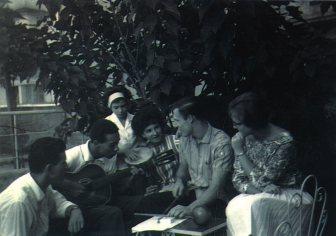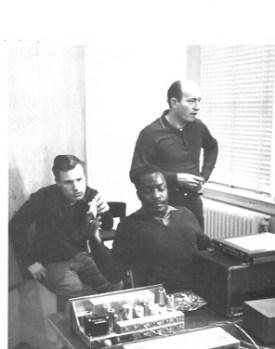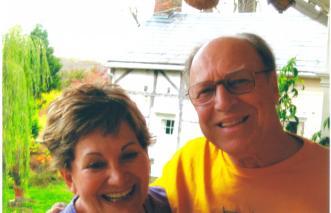
Drummer Buddy Deppenschmidt (center) and Bahian friends, 1961 (Jazz Times)
Never print anything in haste – or in anger – I always say. Well, maybe the time finally came for me to get a taste of my own critical medicine. But first, a little background info.
Back in August 2004, I published an online article called “Damn the Drummer, Where’s the Composer?” It concerned my response to a piece I had read in the June 2004 issue of Jazz Times about drummer Buddy Deppenschmidt’s claim that he was the person who came up with the idea of bringing bossa nova to the United States.
What was his method for having accomplished this incredible feat? According to Buddy, it was via the classic album Jazz Samba, which featured him and bassist Keter Betts, along with two giants of the genre: saxophonist Stan Getz and guitarist Charlie Byrd.
Buddy’s idea of recording an album of freshly minted bossa-nova tunes, which at the time his 1960 State Department-sponsored trip to Brazil took place was an all-but unheard-of genre in North America, turned out to have been a godsend. If anything, it changed the course of both jazz and popular music for all time.
As a native-born Brazilian and lover of the country’s music, my initial reaction to this article was to be “offended” and “put-off” by the sheer brashness of Buddy’s claim. As far as I was concerned there has never been as much recognition for Brazil’s contribution in giving birth to this new style of play as there had been for the American musicians who played it – i.e., Getz, Byrd, Bud Shank, Herbie Mann, Dizzy Gillespie and their ilk. In my mind, credit was “long overdue” to the groundbreaking Brazilian personalities who started it all, and not to “long retired” jazz artists and their alleged “claims,” as I indicated in my rebuttal piece.
To say that I was dead wrong about all this is putting it mildly. Last year, I had the surprise of my life when none other than the “damn” drummer himself, Mr. William “Buddy” Deppenschmidt Jr., wrote me a long-delayed e-mail. Not only was Buddy still around, but he was very much alive and well and living in Bucks County, Pennsylvania.

Buddy, bassist Keter Betts, guitarist Charlie Byrd (standing) listening to playback (Washington Post)
Here’s a sample of what he wrote: “I am not a ‘long retired’ Jazz musician, as you surmise in your August 2004 article in Brazzil Magazine, but lead a busy professional life, performing and teaching. That is why it has taken me a while to find the time to respond to your article… (And the same reason it took me so long to bring my story to light.) I understand why you are proud of your heritage and want to see credit given to great Brazilian composers and musicians.
“My efforts to bring about the making of the seminal album, Jazz Samba, were motivated by love and respect for Bossa Nova, which I was fortunate to hear on our U.S. State Department cultural exchange tour, in 1960. Back home, I listened everyday to the two LPs I got in Brazil and was eager to play this music, but it took about six months of my insistence before Charlie Byrd, Keter Betts and I played it at the Showboat in D.C.”
At age 76, Buddy is (thank goodness) still playing and still going strong. And, as can be seen by his thoroughly insightful commentary, his recollection of the events of his now-historic trip to Brazil is unimpaired and as clear to him as if it happened yesterday.
Buddy went on to write: “The 2004 magazine article, ‘Give the Drummer Some,’ in Jazz Times, is accurate, including all that I stated regarding Stan Getz. [Author] David Adler did a fantastic job of putting the article together and digging up the truth, while trying to be fair to all; so I am sad to see that his and my intentions were at all misunderstood. I wanted the real story, not the fable of the various album liner notes, to be told at last.
“I take credit for my part in the venture as related by Mr. Adler, and no more. Someone else made the remark that I ‘practically invented Bossa Nova.’ I didn’t say that and never would. I considered myself a musical messenger and knew that my message was important, so I still kept driving at it even when they tried, unsuccessfully, to do the album without Keter and me.
“Jazz Samba,” he insisted, “was intended to be an homage to Bossa Nova, which as you know, was little known outside of Brazil in 1961. In fact, the original Odeon recordings of João Gilberto were released here earlier, on the Pacific Jazz label, but went quietly out of print, which is astonishing. When I learned the music and rhythms in Porto Alegre (and I never called it a “master class”) [1] I just wanted to present this music that I love to the American audience; I did not foresee that it would be such a commercial hit. I was busy playing and supporting a family and was therefore unaware of its phenomenal success until much later. I never did reap much financial reward from it and certainly no royalties. Somehow the record company could not come up with any sales figures because it’s so ‘old.’ Nonetheless, you can buy Jazz Samba today at any Barnes & Noble for about twenty bucks.
“I suppose it could be considered an early fusion album,” continued Buddy, “combining American Jazz with the new Brazilian music. It was a heartfelt tribute. The audiences in South America really appreciated our music, so this was an appropriate blend. The success of this record enabled many deserving Brazilian musicians to come to the U. S. and showcase their talents.

Malu & Buddy, Bucks County, October 2010
By the way, the woman you referred to as the ‘mysterious woman’ is Malu Pederneiras,[2] a most generous and hospitable person who cares about other people, even gringos. She has known João Gilberto since childhood. Malu came to visit us here last October 2010. We hadn’t seen each other in 50 years – since the State Department tour. It was a wonderful reunion that meant so much to both of us.
“Malu said, ‘All of this may not have happened if we hadn’t done what we did,’ all the while knowing that the music would have made its way eventually by its incredible universal merits and appeal.”
After that testimonial, what was there left for me to say? Buddy was absolutely correct in his assessment that such major artists as João Gilberto, Tom Jobim, Sergio Mendes, Oscar Castro Neves, Astrud Gilberto, Bola Sete and countless of their countrymen would never have been heard here had it not been for bossa nova opening the country’s doors to them.
Buddy was kind enough to leave me his home telephone number and asked that I get in touch with him, which I did. He even snail-mailed me his four-page press release, which outlined his case in detail. Consequently, we had a long and thoroughly enlightening conversation (and several more after that) that we began – and ended – as fast friends.
My intention in posting this piece on my blog today is not just to set the record straight “going forward” regarding the issue, but to publicize it in a manner that was unavailable to Buddy back in 1961. I do not know if Buddy’s claims and subsequent lawsuit has ever borne fruit; and, as indicated in the original piece, author Adler stated that practically all of the participants involved in the landmark Jazz Samba recording have long since passed on.
We may never know the whole truth behind the revolutionary concept, but I am convinced, by reading Buddy’s letter and press release, listening to his recordings, and speaking to him at length about the matter, that he knows perfectly well what he is talking about; that he absolutely loves Brazilian music; that he both knows and loves Brazil and its people; and that, if he was not the sole individual responsible for bringing bossa nova to the public’s attention, then he came awfully close to doing so!
With that in mind, I took much delight in asking the publishers of the original Website to take down my article, “Damn the Drummer, Where’s the Composer?” and permanently remove it from its online content. I did this of my own free will and in the spirit and recognition of Buddy Deppenschmidt’s unquestioned place in music history, as a true and bona fide American jazz artist, as well as a respected teacher and role model in his community.
It was with the utmost humility (and with a bit of self-deprecating humor) that I concluded the original retraction with the words: “Well, I’ll be damned! The drummer was right after all!!!”
In celebration of the event, and for this most recent reprint, I’d like to add the following postscript: “A happy and healthy upcoming 77th birthday, Buddy! You’ve more than earned it.”
Copyright © 2013 by Josmar F. Lopes
[1] In fairness to my original piece, here is what I wrote: “The original Verve recording does sound positively prehistoric, with a scrawny and suspect rhythm section reminiscent of two street urchins rattling matchboxes at each other. If this was, as the drummer insists, his ‘master class’ in Brazilian rhythm playing, then he definitely needed a few extra lessons prior to graduation. At best, it’s rough hewn and multipurpose, but hardly the stuff of legend.” I did not mean that Buddy was the one giving the “master class,” but rather that he, Buddy, was sitting in on a “master class” being taught by native Brazilians – which was exactly what happened.
[2] Again, here is the gist of what I wrote: “Adler went on to give a detailed description of the Charlie Byrd Trio’s State Department-sponsored visit to South America and Brazil in 1961, specifically to Salvador da Bahia, where Byrd, Deppenschmidt, and Betts were treated to the infectious live sounds of native-born players and the unique voice of Bahian singer-guitarist João Gilberto (via newly bought record albums). A cryptic, chance meeting with a ‘mysterious’ woman admirer led to an informal dinner invitation for Deppenschmidt, who was suitably impressed by the girl’s musically talented family and their helpful instructional insights. This and various other personal recollections by the drummer encompassed what he would later refer to as a virtual on-the-spot master class in basic bossa nova rhythm-playing.”

